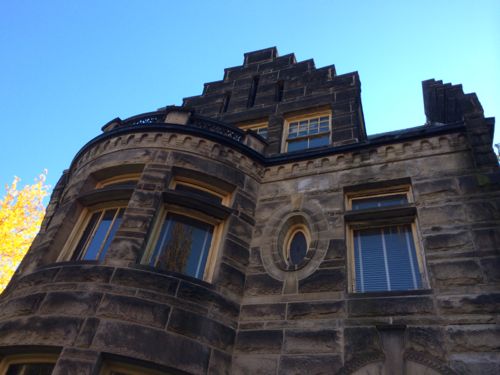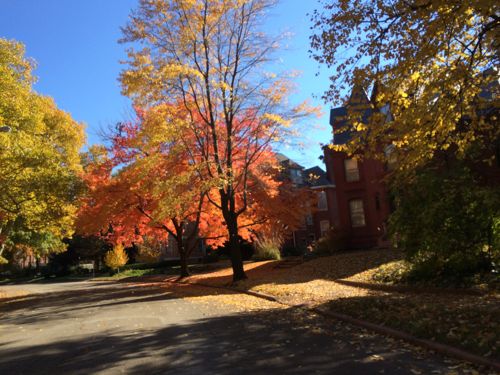Rare Original Compton Heights Mansion
The last occupant of the large home at 3262 Hawthorne was born on August 5, 1908. No, the home hasn’t been vacant for years, he died in January at the age of 104. The home was built in 1893. Here’s his obituary:
Bokern Sr., Eugene A. 104, Fortified with the Sacraments of Holy Mother Church on Thursday, January 17, 2013. Beloved husband of the late Lucille (nee Lynch); loving father of Robert F. (Joyce), Gene Jr, John F. (Shirley), Edward C. (Nina), and the late Karen Sue Watkins; 19 grandchildren, 30 great grandchildren, brother of the late Robert and Francis Bokern; dear cousin, uncle, and friend to many. Services: Visitation Monday, Jan. 21, 4-8pm. Funeral at HOFFMEISTER COLONIAL MORTUARY 6464 Chippewa at Watson, Tuesday, Jan. 22, 10am. Interment Calvary Cemetery. Friends may express condolences at: www.hoffmeistercolonial.com – (Source)

Last Sunday the house was open to lookers even though an offer had just been accepted, see listing & many photos here. A friend I ran into at the open house said he saw the place shortly after the owner had died. It was “stacked high with papers”, he said. On Sunday all the stuff, including old carpets, had been removed. Ideally the original windows will be retained, appropriate reproductions would be very expensive and cheaper windows wouldn’t alter the look significantly.

Apparently the owner had lived there since the 1940s, with few updates. Old boiler with radiators for heat, no central air conditioning. The kitchen and bathrooms were antiques. Fairly original houses like this are very rare, the buyers will have many decisions to make. Do they clean the stone exterior to look like it did in 1893? Or perhaps just a light cleaning so some of the old patina remains?
— Steve Patterson
From an engineer’s perspective, Mr. Bokern did no favors to this structure over the past 70 +/- years. Either he couldn’t afford to own and maintain the home, or for other reasons chose not to part with the $ necessary to properly maintain it. I look at the exterior and I don’t see “patina”. I see soot and grime buildup. Long exposure to atmospheric elements causes copper, brass, bronze to develop “patina”. On porous masonry surfaces like those shown in the first photo, it’s called “Neglect” (with a capital N). And like the surface of your dirty car, dirt/soot buildup on masonry/wood/concrete surfaces will retain/trap moisture and eventually corrode it, which is why those who drive clean, routinely waxed cars seldom see rust and paint deterioration on their car’s surface. In this case, moisture has absorbed into the limestone over the years, eventually wicking through to the interior wyths of masonry, resulting in plaster deterioration/delamination and obvious growth of mold on both exposed and concealed surfaces. And in the process, mortar intended to bond the interior wyths of masonry has lost its strength (dead mortar), compromising the integrity (wind loading/sheer and load-bearing strengths) of the exterior walls, pilasters and (any) masonry columns. Load bearing wood columns and beams that have absorbed moisture over the years may –and probably have–been compromised as well. So, any engineer (and i will go out on a limb and say that even the most conservative architect) would recommend that the entire exterior should be cleaned by a legitimate restoration contractor who won’t be tempted to sand/water-blast the delicate ashlar surface, and then all interfacing mortar joints should be carefully raked and replaced with non-shrink, moisture resistant masonry grout–and then the entire surface should be coated with a clear moisture-resistant coating. I suspect that if the limestone is inspected, you’ll find the classic signs of limestone neglect–scaled layers of limestone that over the years has absorbed moisture that has frozen, then has then expanded and then crumbled! Those areas can easily be patch-repaired in the process. Then and only then can restoration attention be directed to the interior, where resultant damages can then be confidently addressed. Unlike old furniture as we’ve learned on Antiques Roadshow, masonry surfaces must be routinely cleaned and resealed! I’m not criticizing the Bokern family–only pointing out that if you can’t afford maintenance on a home of this type and size, or if you’re an eccentric and for whatever reason choose to live in the ruins, obviously oblivious to the deterioration that’s occurring around you, you need to do the preservationists a favor and get out and move into one of the new condo buildings near Barnes Hospital. (Best wishes to all of the readers of this blog who truly care about STL and all that it offers.)
The issue of “aging in place” will become an increasing issue. This is partly why several of my neighbors are retired. One couple had nearly two acres in St. Louis County, they didn’t want to spend their retirement years maintaining a large home and property. Now they have a loft and a bus-size motorhome to allow them to travel to remote placec.
Overall I’d say the house was maintained fairly well. For all we know, the soot in the facade may have been there on the day he purchased the home — left over from the coal era. The level of cleaning that should take place is debated in preservation circles. Doing nothing isn’t good for longevity vs. making it like new takes away too much of the history. I like the middle of the two.
What has been allowed to happen at that house is akin to what happened at Cupples 7, but to a lesser degree (this time).
Obviously, only the “one per cent” can afford these types of houses
Wow, some of the most spectacular plaster work I’ve ever seen (note: the pix on the real estate site are c-r-a-p; loaded at a laughably low res). Truly, a fantastic house. Yeah, some issues with peeling paint, and plaster delaminating from the lath, but not the worst by far that I’ve seen. Ideally, the new owners will put their first round of spending into repairing/replacing the roof, and having the brick and stone joints thoroughly repointed (please, please, please, use the same ‘rope’ joint strike; love that!), and maybe have a look at the foundation. The interior stuff seems to be repairing and updating, with a focus on plaster walls/ceilings, RESTORING the old cypress wood (most likely) windows, the HVAC/plumbing etc. Maybe sweep the chimneys, too. 50K min., 100K would be ideal for starts, on the more serious exterior and interior defects. Gotta agree with Tom, DO NOT use sand-blasting on stone/brick! Heck, it’s mostly just coal soot, anyway. A good scrubbing with a soft nylon brush, with a mild detergent should work (though I wouldn’t do this unless the temps were going to be above freezing for at least a week, and rain isn’t forecast; for a good example of a brick building which was sandblasted, and resulted in damaged brick, take a look at the Thurman Grill building at Thurman and Shenandoah: the porous interior of the brick has been exposed, not to mention that the mortar mix was too wet when it was repointed, as vertical cracks have since developed in the joints).
Good luck to the new owners. Call me before the house goes on the CH tour, my wife and I would like a personally-guided tour of the joint in its newly-restored state. Please 🙂
My grandfather was the owner of this home..it didn’t always look like that, when my grandmother passed in 1994 , he didn’t see any reason to up keep the house for himself.. he was a very proud man and could have very well afford to make improvements .. however he was a tightwad as well.. but would also have given you the shirt off his back and all the money in his pocket if he thought you needed it more than he did.. he had 19 of us grandkids, we all offered to cut trees ,grass clean the house for him , but he would not allow it.. didn’t want to take our time or put us out, but would go out of his way for all 19 of us….
Steve – if you’d delved deeper to the original owners of this house, you may have seen a familiar name. It was my great (or great great grandfather).